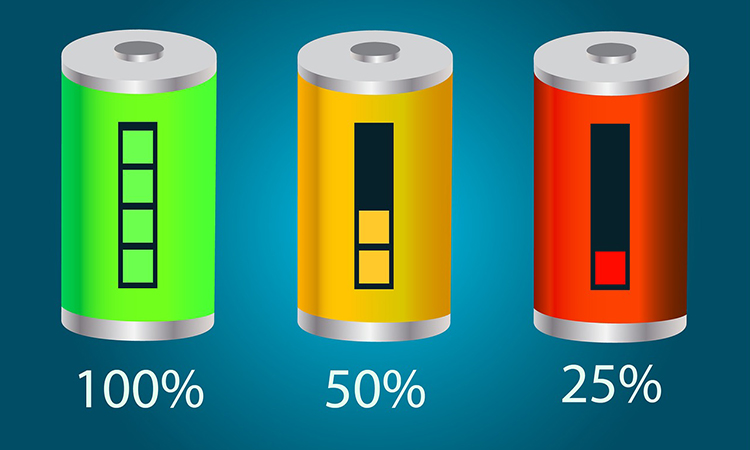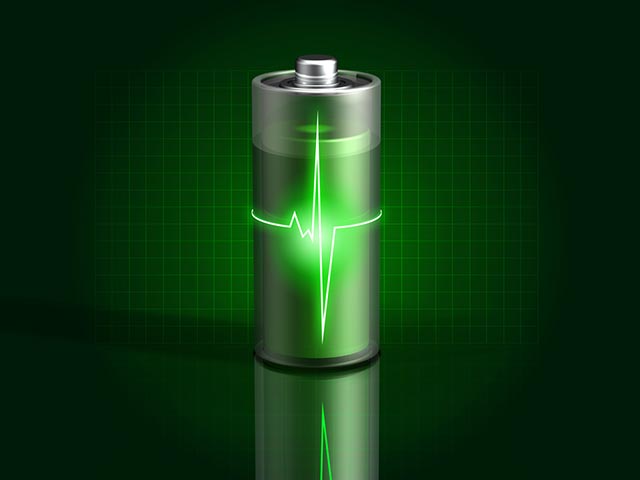Anatomy of Batteries
When looking at batteries, it is seen that they have two poles, plus and minus (positive and negative). Flashlights, TV remotes, etc. The batteries used in the devices are cylindrical and the poles are at opposite ends. In automobile batteries (batteries are also batteries), the poles are side by side on the top of the battery. If the two poles of a battery are connected by a conductor, the electrons start to move from the negative pole to the positive pole with great speed. In this case, the battery will run out in a short time. It is also dangerous, especially with large, high-capacity batteries. The poles of the batteries should not be connected directly to each other, light bulbs, electric motors, etc. are passed through a resistor. Thus, the batteries can be used properly.
The outside of the batteries is covered with a metal or plastic cover. Under this cover, there is a cathode connected to the positive pole and an anode connected to the negative pole. These components are more commonly called electrodes. The electrodes make up the bulk of the battery, and the chemical reaction that produces electricity also takes place on the electrodes. A separator layer separates the electrodes from each other, preventing them from coming into contact, while not impeding the free movement of electrons. The medium in which electron flow takes place between the anode and the cathode is called the electrolyte.
Battery Development from Past to Present
Imagine a world where all kinds of machines and devices that need electricity to work must be plugged in. To power flashlights, hearing aids, cell phones, and other portable devices, they had to be connected to the outlet, which greatly affected the usability of the devices. Cars couldn't run either. All sides would be surrounded by electrical wires, which would pose a serious risk to people. Happily, batteries eliminate all these negativities and make people's lives easier than they realize in daily life.
Although there are many different types and structures of batteries, the basic working principles are always the same. When a device is connected to the battery, a chemical reaction occurs, producing current. The reaction here is called an electrochemical reaction. Italian physicist Alessandro Volta (Alessandro Giuseppe Antonio Anastasio Volta) made the first simple battery in 1799 with metal sheets and cardboard soaked in water. Since then, scientists have developed Volta's original design, used many minerals, and produced batteries of various sizes and capacities.
Today, batteries are all around us. Our wristwatches, mobile phones, mp3 players, portable computers, remotes, and many more machines and devices contain batteries that keep them running. If you are reading this article from your mobile phone or portable computer, you are currently using batteries. In this article, we will make an in-depth analysis of the general structures of batteries, their history, and the chemical reactions that take place in batteries.
Chemical Reactions in Batteries
When you connect a battery to any circuit, many things happen inside the battery. Although the chemical reactions that produce electricity differ from battery to battery, the basic logic is always the same.
When a device is connected to the positive and negative poles of the battery, when the circuit is completed, a series of chemical reactions take place in the battery, and electricity is produced. The ions (electrically charged atoms or molecules) in the electrolyte combine with the anode and perform an oxidation reaction. Meanwhile, a new compound is formed and electrons or electrons are released. At the same time, ions and free electrons form a new compound at the cathode. Although it may seem complicated, these events are quite simple. Reactions taking place at the anode produce free electrons. In the reaction that takes place at the cathode, the free electrons produced at the anode are used. The battery continues to produce electricity until at least one of the materials used as an anode and cathode is depleted.
Various chemicals are used to speed up chemical reactions in modern batteries. Different chemicals used have led to the emergence of different battery types. These:
Zinc-Carbon Batteries
They are cheap batteries. Zinc is used as the anode and manganese dioxide is used as the cathode. Ammonium chloride or zinc chloride is used as the electrolyte.
Alkaline Batteries
Powdered zinc is used as the anode and manganese dioxide is used as the cathode. The reason why it is called alkaline is due to the use of potassium hydroxide, an alkaline compound, as the electrolyte.
Historical Development of the Battery
The history of batteries goes way back than you can imagine. In 1938, archaeologist Wilhelm Konig discovered strange clay cobbles while excavating near Baghdad. These vessels, which are approximately 13 cm in length and are understood to date from the 2000s BC, contained iron rods covered with copper. As a result of the tests, it was understood that an acidic liquid such as vinegar was once placed in these containers. This result led Konig to conclude that the vessels he found were batteries from ancient times. After this discovery, it was seen that they could indeed produce electric current by making similar ancient ruins. It is estimated that the electricity produced by these vessels may have been used in religious rituals, for therapeutic purposes, and even for galvanic coating purposes.
Known as the Italian physicist Alessandro Volta Volta battery in 1799, this mechanism is not the first to produce electricity, but it is the first to produce constant and long-term electricity. However, Volta's discovery had some weaknesses. The boards had to be limited in size so that they wouldn't compress the cardboard or fabric and expel the salt water. In addition, metal sheets were rapidly eroding, and these negativities caused the Volta battery to have a very short lifespan. Despite all these shortcomings, the unit of electromotive force and a potential difference is named Volt in the SI unit system in honor of Volta.
The second major development in the history of batteries was the British chemist John Frederick Daniell's construction of the Daniell battery in 1836. In the Daniell battery, a copper plate was placed at the bottom of a glass jar, the jar was half filled with copper sulfate solution, a zinc plate was hung above the copper sulfate solution, and then the remainder of the bowl was filled with zinc sulfate. Since copper sulfate is denser than zinc sulfate, the two solutions do not mix, copper sulfate at the bottom stands with zinc sulfate at the top, and the zinc plate remains covered with zinc sulfate solution. The cable connected to the zinc plate acts as the negative pole, and the cable connected to the copper plate acts as the positive pole. The Daniell battery (Daniell battery) was an ideal solution for stationary machines and appliances and was used as a power source for doorbells and telephones until electricity generation and distribution improved.
Lithium Ion Batteries
The most important feature of these batteries, which are used in high-performance devices such as mobile phones, cameras, and portable computers, is that they are rechargeable. Although a wide variety of compounds are used in lithium-ion batteries, carbon anode is mostly used together with lithium cobalt oxide cathode.
Lead Acid Batteries (Battery)
These are the batteries used in motor vehicles. The lead dioxide and metal lead are generally used as electrodes, while the sulfuric acid solution is used as electrolytes. They are rechargeable batteries.
Rechargeable Batteries
As devices such as portable computers and mobile phones began to be used intensively, the need and demand for rechargeable batteries increased rapidly. Rechargeable batteries have been in the human world since French physicist Gaston Plante invented the first battery, the lead acid battery, in 1859. Using a lead anode and lead oxide cathode and a sulfuric acid electrolyte, Plante also enabled the development of modern-day automobiles.
Rechargeable and non-rechargeable batteries generate electricity in the same way. We have described these reactions above. However, the reactions that take place in non-rechargeable batteries are irreversible. So they are not reversible reactions. In rechargeable batteries, on the other hand, when the battery is energized, the reactions that occur while the battery produces electricity are reversed, that is, in the opposite direction. Lithium-ion (LiOn) batteries are the most widely used rechargeable batteries. However, Nickel Metal Hydride (NiMH) and Nickel Cadmium (NiCd) batteries are other types of rechargeable batteries that may be encountered.
Not all rechargeable batteries have the same effectiveness. For example, Ni-Cd batteries were once the most widely used rechargeable batteries, but they had a problem called the memory effect. If these batteries are used without being fully discharged, they lose their capacity in a short time. For this reason, Ni-Cd batteries are not used much nowadays. Although the memory effect is minimal in Ni-MH batteries, these batteries have a short shelf life. Like Ni-MH batteries, Li-On batteries also have a long life. At the same time, they maintain their charge for a long time, can provide high voltages, and are lightweight and compact. For this reason, Li-On batteries are used in today's high-tech devices such as mobile phones, tablet computers, and laptop computers. However, Li-On batteries are not produced much because they are expensive in standard (such as A-AA-AAA) sizes.
Ni-Cd and Ni-MH batteries should be charged carefully. If they are overcharged, their electricity storage capacity is reduced. For this reason, many chargers are designed to automatically stop charging when the batteries are charged.
Ni-Cd and Ni-MH batteries should be charged carefully. If they are overcharged, their electricity storage capacity is reduced. This is why many chargers are built to automatically stop charging when the batteries are charged. At the same time, to maintain the capacity of Ni-Cd and Ni-MH batteries, it is necessary to charge them after they are completely exhausted. Li-On batteries, on the other hand, have special charging equipment that prevents overcharging, and there is no need to completely consume the battery for charging.
Rechargeable batteries also eventually expire. However, they do have a very long life if they are handled with care. Batteries contain very dangerous chemicals for nature. For this reason, batteries that have expired must be recycled and not thrown into the environment.
Source: Tubitak Peter Adamczyk-Paul-Francis Law



